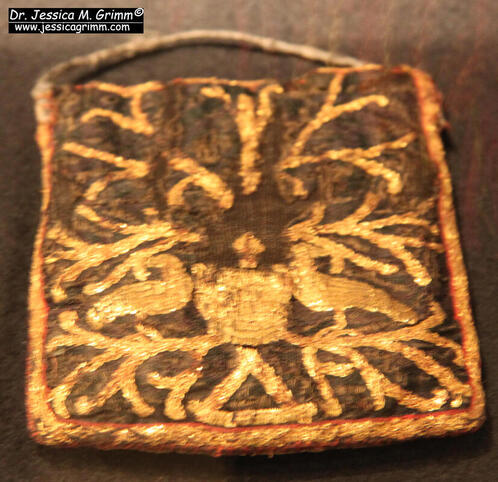|
Last week, I and my husband visited the Diocesan Museum of St Afra in Augsburg. That's possibly the closest church museum with textiles in relation to where we live, but we had never been there. And that's a shame as it is a charming little museum. Besides ecclesiastical art and historical pieces, you can also see parts of Roman Augsburg below your feet. The excavations have been left open for you to admire. The museum itself is a combination of modern architecture and the historical cathedral cloisters. So what is on display? Quite spectacular are two chasubles dating to the 10th-century. These vestments are associated with bishop Ulrich of Augsburg (AD 890-973). Ulrich lived during turbulent times. He was a friend of Emperor Otto I and successfully defended Augsburg against the marauding Magyars from Hungary. Apparently, he also wrote a treatise on celibacy stating that it was not supported by the bible. All this made Ulrich famous during his lifetime and he became a saint soon after his death. Vestments associated with him became important relics and were held in high esteem. But there was a small problem. Ulrich liked simple clothing. Nothing flashy. His mantle made of local linen was just too plain for the average 12th-century believer. Thus, tiny appliques of silk with goldwork embroidery were added. That's rather cute, don't you think? The museum houses several quite old embroidered textiles. As they need to be displayed at low lighting levels, photographing them is near impossible. However, as I have shown the spectacular embroideries from Bamberg before, I would like to show the above. This small reliquary pouch made of dark purple or blue silk (samite?) with gold embroidery was made in Southern Germany in the 12th-century. Roughly a hundred years later than the pieces on display in Bamberg. But the embroidery technique of couching down very pure goldthreads and hammering them flat is the same. I think the pouch displays two birds (peacocks?) amongst some foliage and maybe a coat of arms. Unfortunately, there was hardly any information on the piece available. The last piece I would like to show is a small reliquary casket. I have never seen anything like it. It looks like an orphrey being glued to a small wooden box. The saint depicted is St Agnes. She is stitched in brick stitch with silks. The background displays a diaper couching pattern; one I haven't seen before. The casket was made in the 13th-century, possibly in Cologne. Quite an unusual piece. And a reminder that embroidery was probably much more widely used. It simply did not survive until the modern-day.
Sadly, this will be my last field trip for a while. Corona numbers are going up in Germany as well. Since I am living in an area with a rather low rate of infections, I don't want to introduce the virus. My husband and I have decided to avoid travelling and gatherings as much as we can until the numbers go down again. Hope you are all safe! P.S. I am being featured in the latest issue of Metier magazine! The article, in Dutch, talks about me and my historically inspired goldwork embroideries.
5 Comments
Pat
26/10/2020 12:33:35
Wise to stay home and stay safe.
Reply
26/10/2020 16:23:00
Yes, it is just not worth the risk. And luckily for all of us, we can stay conected digitally!
Reply
26/10/2020 16:25:02
Indeed Rachel. Especially those pieces that have this near-pure goldthread. I start to recognise that stuff now. It is so much more shiny than the other varieties of goldthread. These pieces really only survived because they were associated with certain important persons.
Reply
Your comment will be posted after it is approved.
Leave a Reply. |
Want to keep up with my embroidery adventures? Sign up for my weekly Newsletter to get notified of new blogs, courses and workshops!
Liked my blog? Please consider making a donation or becoming a Patron so that I can keep up the good work and my blog ad-free!
Categories
All
Archives
July 2024
|
Contact: info(at)jessicagrimm.com
Copyright Dr Jessica M. Grimm - Mandlweg 3, 82488 Ettal, Deutschland - +49(0)8822 2782219 (Monday, Tuesday, Friday & Saturday 9.00-17.00 CET)
Impressum - Legal Notice - Datenschutzerklärung - Privacy Policy - Webshop ABG - Widerrufsrecht - Disclaimer
Copyright Dr Jessica M. Grimm - Mandlweg 3, 82488 Ettal, Deutschland - +49(0)8822 2782219 (Monday, Tuesday, Friday & Saturday 9.00-17.00 CET)
Impressum - Legal Notice - Datenschutzerklärung - Privacy Policy - Webshop ABG - Widerrufsrecht - Disclaimer








 RSS Feed
RSS Feed